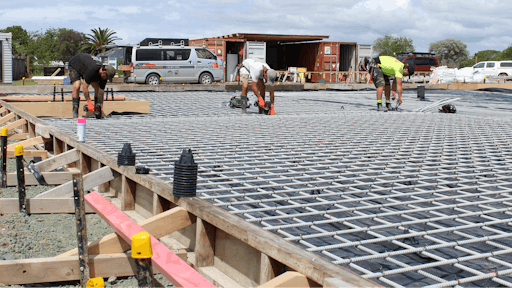Composites: Strong and Durable Building And Construction Materials
Composites: Strong and Durable Building And Construction Materials
Blog Article
Opening the Environmental Benefits of Recycled Composites in Building and Layout
In the world of construction and design, the usage of recycled compounds holds significant guarantee for enhancing sustainability practices and lowering environmental impact. The change in the direction of a much more lasting future in these markets pivots on unlocking the full potential of recycled composites.

Ecological Impact Decrease
The decrease of environmental effect with using recycled compounds in construction and design plays an important role in lasting practices. By incorporating recycled composites into structure materials, the building and construction industry can significantly decrease its carbon footprint and add to a much more environmentally friendly future. These lasting materials, made from repurposed plastics, wood fibers, or various other recycled components, provide a sensible choice to traditional building products without endangering on top quality or sturdiness.
Recycled composites assist divert waste from garbage dumps and minimize the requirement for drawing out basic materials, hence conserving natural resources. In addition, the production process of these compounds often consumes much less energy and gives off less greenhouse gases compared to generating virgin products (composites). This shift in the direction of using recycled compounds not just reduces ecological injury yet likewise advertises a circular economic situation by urging the reuse of products that would certainly otherwise be discarded
Waste Minimization
With an emphasis on minimizing waste in building and construction and design, the assimilation of recycled composites supplies a sustainable service to decrease environmental influence. Waste minimization is an essential element of sustainable techniques, and using recycled compounds offers a chance to attain this goal successfully. By utilizing products that have actually already served their first function, such as recycled plastics or recovered timber fibers, the building and design markets can substantially decrease the amount of waste produced and sent to garbage dumps.
Recycled composites have the potential to draw away substantial quantities of waste from typical disposal techniques, contributing to a more circular economic climate where resources are utilized successfully. Additionally, the manufacturing process of recycled compounds frequently consumes much less power and creates less exhausts compared to virgin materials, further lowering the ecological footprint of building and design projects.
Applying waste reduction techniques through the incorporation of recycled compounds not just assists in conserving natural deposits but also promotes an extra sustainable approach to building and designing for a greener future.
Power Preservation
Incorporating recycled compounds not just minimizes waste in construction and design but also plays a critical role in enhancing power preservation methods within the industry. Making use of recycled compounds in building can considerably add to energy preservation through various means. The production of virgin products typically requires substantial power inputs, whereas utilizing recycled compounds consumes less energy, thereby decreasing overall power consumption. In addition, integrating recycled composites can add to far better insulation residential or commercial properties in structures, decreasing the need for too much home heating or air conditioning, and as a result reducing energy use for environment control. Furthermore, the light-weight nature of many recycled compounds can cause lighter structures, requiring less power for transportation and installment. By advertising using recycled composites in construction and layout, the sector can make substantial strides towards achieving power efficiency and decreasing its carbon footprint, ultimately adding to a much more sustainable constructed setting.
Carbon Footprint Decrease
Enhancing sustainability practices through the utilization of recycled composites in building and style significantly reduces the carbon impact of the market. By integrating recycled products right into the production of composites, the need for virgin resources decreases, bring about reduced energy intake and greenhouse gas emissions connected with standard manufacturing procedures. This decrease in carbon footprint is vital in combating climate modification and promoting a much more eco pleasant strategy to building and design.
The carbon footprint browse around these guys reduction attained via the fostering of recycled composites aligns with the global push towards lasting practices and the decrease of industrial emissions. Eventually, by focusing on the combination of recycled compounds, the market can make considerable strides in decreasing its carbon footprint and adding to an extra lasting future.
Lasting Future
The integration of recycled compounds read review in construction and layout not just addresses prompt environmental worries yet additionally lays a strong structure for a sustainable future in the market. By including recycled composites into structure materials and items, the construction and design markets can substantially minimize their reliance on virgin resources, resulting in a more round economy. This change in the direction of sustainability is essential for mitigating the environmental impact of traditional building and construction methods, which typically lead to high degrees of waste generation and source depletion.

Final Thought
To conclude, recycled composites use significant ecological advantages in building and layout by minimizing environmental influence, reducing waste, conserving power, decreasing carbon impact, and promoting a sustainable future. Accepting the use of recycled composites can add to a more environmentally-friendly technique to structure and design, ultimately resulting in an extra lasting and greener future for all.
The decrease of ecological effect with the usage of recycled composites in construction and layout plays a crucial function in sustainable methods.With a focus on minimizing waste in building and layout, the combination of recycled compounds offers a sustainable option to decrease environmental impact. By promoting the use of recycled composites in building and construction and design, the market can make substantial strides in the direction of accomplishing Web Site power efficiency and lowering its carbon impact, eventually adding to a more lasting constructed environment.

Report this page